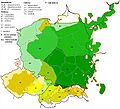The Slavic first palatalization is a Proto-Slavic sound change that manifested as regressive palatalization of inherited Balto-Slavic velar consonants... 8 KB (1,015 words) - 08:48, 30 May 2023 |
the progressive palatalization. A dissenting view places the progressive palatalization before one or both regressive palatalizations. This dates back... 75 KB (9,348 words) - 17:58, 9 April 2024 |
Slavic palatalization may refer to: Slavic first palatalization, the first palatalization affecting the Slavic languages Slavic second palatalization... 332 bytes (69 words) - 20:20, 1 May 2023 |
velar consonants that occurred after the first and before the third Slavic palatalizations. The second palatalization of velars is a direct consequence of... 8 KB (859 words) - 21:42, 31 January 2024 |
 | Slavic first palatalization. This use is based on the Czech alphabet, and is shared by most Slavic languages and linguistic explanations about Slavic... 74 KB (7,528 words) - 22:41, 6 April 2024 |
fronting or raising of vowels. In some cases, palatalization involves assimilation or lenition. Palatalization is sometimes an example of assimilation. In... 34 KB (2,940 words) - 04:23, 9 April 2024 |
Iotation (category Articles with text in Slavic languages) In Slavic languages, iotation (/joʊˈteɪ.ʃən/, /ˌaɪ.oʊˈteɪ.ʃən/) is a form of palatalization that occurs when a consonant comes into contact with the palatal... 10 KB (768 words) - 04:33, 31 March 2024 |
Balto-Slavic *ś, *ź, *ź, and further into Slavic *s, *z, *z. The first regressive palatalization of velars. The second regressive palatalization of velars... 62 KB (7,581 words) - 01:51, 3 April 2024 |
 | following: Phonetic palatalization only exists in Latvian and not Lithuanian or Old Prussian. This means phonetic palatalization could not have existed... 59 KB (6,831 words) - 18:15, 12 April 2024 |
 | Old Church Slavonic (redirect from Old Slavic (term)) or Old Slavonic (/sləˈvɒnɪk, slæˈvɒn-/ slə-VON-ik, slav-ON-) is the first Slavic literary language. Historians credit the 9th-century Byzantine missionaries... 111 KB (11,884 words) - 21:22, 26 April 2024 |
A Slavic name suffix is a common way of forming patronymics, family names, and pet names in the Slavic languages. Many, if not most, Slavic last names... 8 KB (381 words) - 01:01, 16 March 2024 |
Robert (1972), On the Place of the Progressive Palatalization of Velars in the Relative Chronology of Slavic, The Hague: Mouton Lehr-Spławiński, Tadeusz... 103 KB (1,950 words) - 09:08, 10 April 2024 |
Serbo-Croatian phonology (category Slavic phonologies) ('what kind of') – kàkvi, sȁv ('entire') – svȉ The reflex of the Slavic first palatalization was retained in Serbo-Croatian as an alternation of /k/ → /t͡ʂ/... 45 KB (4,174 words) - 08:59, 18 April 2024 |
History of the Russian language (category Articles containing Old East Slavic-language text) the case of Proto-Slavic *ę > Russian ja, the palatalization of the preceding consonant was due to the general Russian palatalization before all front... 64 KB (6,489 words) - 17:09, 9 March 2024 |
 | Eastern Slavic group, but not the Western Slavic. These include: Consistent application of Slavic second palatalization before Proto-Slavic *v Loss of... 42 KB (3,952 words) - 18:37, 26 April 2024 |
 | Church Slavonic (redirect from Church Slavic) Church Slavic, New Church Slavonic, New Church Slavic or just Slavonic (as it was called by its native speakers), is the conservative Slavic liturgical... 26 KB (2,781 words) - 11:07, 17 April 2024 |
The Eastern South Slavic dialects form the eastern subgroup of the South Slavic languages. They are spoken mostly in Bulgaria and North Macedonia, and... 71 KB (7,773 words) - 05:40, 25 March 2024 |
 | Ukrainian alphabet (category Articles containing Old East Slavic-language text) do not palatalize a preceding consonant. The digraphs дз and дж are normally used to represent single affricates /d͡z/ and /d͡ʒ/. Palatalization of consonants... 49 KB (2,868 words) - 21:19, 22 March 2024 |
 | Slavomolisano dialect (redirect from Molise Slavic language) Slavomolisano, also known as Molise Slavic or Molise Croatian (Croatian: Moliški hrvatski; Italian: croata molisana), is a variety of Shtokavian Croatian... 30 KB (2,902 words) - 17:30, 26 April 2024 |
In Proto-Slavic, these were monophthongized as follows, with the subscript indicating whether the vowels trigger the first palatalization or the second... 4 KB (437 words) - 21:37, 31 January 2024 |
 | Cyrillic alphabets (section Slavic languages) East Slavic ones in that the alphabet has generally been simplified: Letters such as Я, Ю, Ё, and Ь representing /ja/, /ju/, /jo/, and palatalization in... 103 KB (4,846 words) - 01:30, 24 April 2024 |
Ukrainian phonology (category Slavic phonologies) no agreement about the nature of the palatalization of /rʲ/; sometimes, it is considered as a semi-palatalized[clarification needed] consonant. The labial... 27 KB (2,708 words) - 23:26, 23 April 2024 |
Old Novgorod dialect (category Articles with text in Slavic languages) lost in other Slavic dialects, such as the absence of second palatalization. Furthermore, letters provide unique evidence of the Slavic vernacular, as... 14 KB (1,611 words) - 00:51, 15 April 2024 |
ancestral Proto-Slavic language. Over time, many of the original changes have been reversed or levelled out. The Slavic first palatalization causes alternations... 37 KB (4,712 words) - 04:35, 5 February 2024 |
 | Bulgarian language (redirect from Bulgarian Slavic language) phonemic palatalization is more circumscribed than in R. For one thing, phonemic palatalization in B is clearly secondary; we recall that SSL South Slavic Languages... 113 KB (12,970 words) - 04:48, 22 April 2024 |



